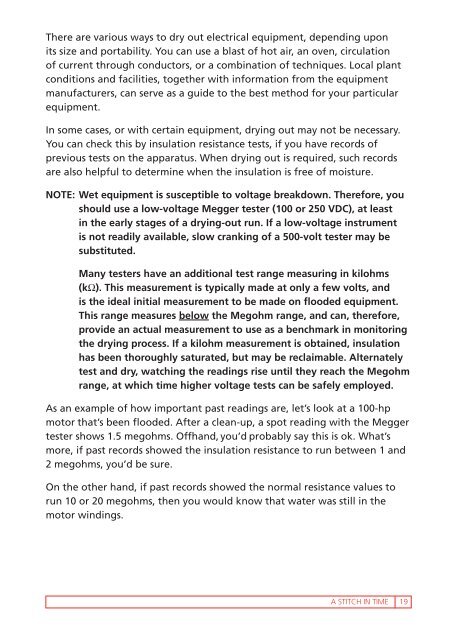“A Stitch in Time...”
Create successful ePaper yourself
Turn your PDF publications into a flip-book with our unique Google optimized e-Paper software.
There are various ways to dry out electrical equipment, depend<strong>in</strong>g upon<br />
its size and portability. You can use a blast of hot air, an oven, circulation<br />
of current through conductors, or a comb<strong>in</strong>ation of techniques. Local plant<br />
conditions and facilities, together with <strong>in</strong>formation from the equipment<br />
manufacturers, can serve as a guide to the best method for your particular<br />
equipment.<br />
In some cases, or with certa<strong>in</strong> equipment, dry<strong>in</strong>g out may not be necessary.<br />
You can check this by <strong>in</strong>sulation resistance tests, if you have records of<br />
previous tests on the apparatus. When dry<strong>in</strong>g out is required, such records<br />
are also helpful to determ<strong>in</strong>e when the <strong>in</strong>sulation is free of moisture.<br />
NOTE: Wet equipment is susceptible to voltage breakdown. Therefore, you<br />
should use a low-voltage Megger tester (100 or 250 VDC), at least<br />
<strong>in</strong> the early stages of a dry<strong>in</strong>g-out run. If a low-voltage <strong>in</strong>strument<br />
is not readily available, slow crank<strong>in</strong>g of a 500-volt tester may be<br />
substituted.<br />
Many testers have an additional test range measur<strong>in</strong>g <strong>in</strong> kilohms<br />
(kW). This measurement is typically made at only a few volts, and<br />
is the ideal <strong>in</strong>itial measurement to be made on flooded equipment.<br />
This range measures below the Megohm range, and can, therefore,<br />
provide an actual measurement to use as a benchmark <strong>in</strong> monitor<strong>in</strong>g<br />
the dry<strong>in</strong>g process. If a kilohm measurement is obta<strong>in</strong>ed, <strong>in</strong>sulation<br />
has been thoroughly saturated, but may be reclaimable. Alternately<br />
test and dry, watch<strong>in</strong>g the read<strong>in</strong>gs rise until they reach the Megohm<br />
range, at which time higher voltage tests can be safely employed.<br />
As an example of how important past read<strong>in</strong>gs are, let’s look at a 100-hp<br />
motor that’s been flooded. After a clean-up, a spot read<strong>in</strong>g with the Megger<br />
tester shows 1.5 megohms. Offhand, you’d probably say this is ok. What’s<br />
more, if past records showed the <strong>in</strong>sulation resistance to run between 1 and<br />
2 megohms, you’d be sure.<br />
On the other hand, if past records showed the normal resistance values to<br />
run 10 or 20 megohms, then you would know that water was still <strong>in</strong> the<br />
motor w<strong>in</strong>d<strong>in</strong>gs.<br />
A STITCH IN TIME 19



